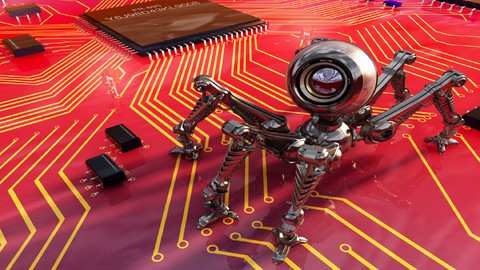
Modern Computer Vision GPT, PyTorch, Keras, OpenCV4 in 2024!
Modern Computer Vision GPT, PyTorch, Keras, OpenCV4 in 2024!, available at $94.99, has an average rating of 4.34, with 255 lectures, based on 1505 reviews, and has 12703 subscribers.
You will learn about All major Computer Vision theory and concepts (updated in late 2023!) Learn to use PyTorch, TensorFlow 2.0 and Keras for Computer Vision Deep Learning tasks YOLOv8: Cutting-edge Object Recognition DINO-GPT4V: Next-Gen Vision Models Learn all major Object Detection Frameworks from YOLOv8, R-CNNs, Detectron2, SSDs, EfficientDetect and more! Deep Segmentation with Segment Anything, U-Net, SegNet and DeepLabV3 Understand what CNNs 'see' by Visualizing Different Activations and applying GradCAM Generative Adverserial Networks (GANs) & Autoencoders – Generate Digits, Anime Characters, Transform Styles and implement Super Resolution Training, fine tuning and analyzing your very own Classifiers Facial Recognition along with Gender, Age, Emotion and Ethnicity Detection Neural Style Transfer and Google Deep Dream Transfer Learning, Fine Tuning and Advanced CNN Techniques Important Modern CNNs designs like ResNets, InceptionV3, DenseNet, MobileNet, EffiicentNet and much more! Tracking with DeepSORT Siamese Networks, Facial Recognition and Analysis (Age, Gender, Emotion and Ethnicity) Image Captioning, Depth Estimination and Vision Transformers Point Cloud (3D data) Classification and Segmentation Making a Computer Vision API and Web App using Flask OpenCV4 in detail, covering all major concepts with lots of example code All Course Code works in accompanying Google Colab Python Notebooks Meta CLIP for Enhanced Image Analysis This course is ideal for individuals who are College/University Students of all levels Undergrads to PhDs (very helpful for those doing projects) or Software Developers and Engineers looking to transition into Computer Vision or Start up founders lookng to learn how to implement thier big idea or Hobbyist and even high schoolers looking to get started in Computer Vision It is particularly useful for College/University Students of all levels Undergrads to PhDs (very helpful for those doing projects) or Software Developers and Engineers looking to transition into Computer Vision or Start up founders lookng to learn how to implement thier big idea or Hobbyist and even high schoolers looking to get started in Computer Vision.
Enroll now: Modern Computer Vision GPT, PyTorch, Keras, OpenCV4 in 2024!
Summary
Title: Modern Computer Vision GPT, PyTorch, Keras, OpenCV4 in 2024!
Price: $94.99
Average Rating: 4.34
Number of Lectures: 255
Number of Published Lectures: 254
Number of Curriculum Items: 255
Number of Published Curriculum Objects: 254
Original Price: $199.99
Quality Status: approved
Status: Live
What You Will Learn
- All major Computer Vision theory and concepts (updated in late 2023!)
- Learn to use PyTorch, TensorFlow 2.0 and Keras for Computer Vision Deep Learning tasks
- YOLOv8: Cutting-edge Object Recognition
- DINO-GPT4V: Next-Gen Vision Models
- Learn all major Object Detection Frameworks from YOLOv8, R-CNNs, Detectron2, SSDs, EfficientDetect and more!
- Deep Segmentation with Segment Anything, U-Net, SegNet and DeepLabV3
- Understand what CNNs 'see' by Visualizing Different Activations and applying GradCAM
- Generative Adverserial Networks (GANs) & Autoencoders – Generate Digits, Anime Characters, Transform Styles and implement Super Resolution
- Training, fine tuning and analyzing your very own Classifiers
- Facial Recognition along with Gender, Age, Emotion and Ethnicity Detection
- Neural Style Transfer and Google Deep Dream
- Transfer Learning, Fine Tuning and Advanced CNN Techniques
- Important Modern CNNs designs like ResNets, InceptionV3, DenseNet, MobileNet, EffiicentNet and much more!
- Tracking with DeepSORT
- Siamese Networks, Facial Recognition and Analysis (Age, Gender, Emotion and Ethnicity)
- Image Captioning, Depth Estimination and Vision Transformers
- Point Cloud (3D data) Classification and Segmentation
- Making a Computer Vision API and Web App using Flask
- OpenCV4 in detail, covering all major concepts with lots of example code
- All Course Code works in accompanying Google Colab Python Notebooks
- Meta CLIP for Enhanced Image Analysis
Who Should Attend
- College/University Students of all levels Undergrads to PhDs (very helpful for those doing projects)
- Software Developers and Engineers looking to transition into Computer Vision
- Start up founders lookng to learn how to implement thier big idea
- Hobbyist and even high schoolers looking to get started in Computer Vision
Target Audiences
- College/University Students of all levels Undergrads to PhDs (very helpful for those doing projects)
- Software Developers and Engineers looking to transition into Computer Vision
- Start up founders lookng to learn how to implement thier big idea
- Hobbyist and even high schoolers looking to get started in Computer Vision
Welcome to Modern Computer Vision Tensorflow, Keras & PyTorch!
AI and Deep Learning are transforming industries and one of the most intriguing parts of this AI revolution is in Computer Vision!
Update for 2024: Modern Computer Vision Course
-
We’re excited to bring you the latest updates for our 2024 modern computer vision course. Dive into an enriched curriculum covering the most advanced and relevant topics in the field:
-
YOLOv8: Cutting-edge Object Recognition
-
DINO-GPT4V:Next-Gen Vision Models
-
Meta CLIP for Enhanced Image Analysis
-
Detectron2for Object Detection
-
Segment Anything
-
Face Recognition Technologies
-
Generative AI Networks for Creative Imaging
-
Transformersin Computer Vision
-
Deploying & Productionizing Vision Models
-
Diffusion Models for Image Processing
-
Image Generationand Its Applications
-
Annotation Strategy for Efficient Learning
-
Retrieval Augmented Generation (RAG)
-
Zero-Shot Classifiers for Versatile Applications
-
Using Roboflow: Streamlining Vision Workflows
What is Computer Vision?
But what exactly is Computer Vision and why is it so exciting? Well, what if Computers could understand what they’re seeing through cameras or in images? The applications for such technology are endless from medical imaging, military, self-driving cars, security monitoring, analysis, safety, farming, industry, and manufacturing! The list is endless.
Job demand for Computer Vision workers are skyrocketing and it’s common that experts in the field are making USD $200,000 and more salaries.However, getting started in this field isn’t easy. There’s an overload of information, many of which is outdated, and a plethora of tutorials that neglect to teach the foundations. Beginners thus have no idea where to start.
This course aims to solve all of that!
-
Taught using Google Colab Notebooks(no messy installs, all code works straight away)
-
27+ Hours of up-to-date and relevant Computer Vision theory with example code
-
Taught using both PyTorch and Tensorflow Keras!
In this course, you will learn the essential very foundations of Computer Vision, Classical Computer Vision (using OpenCV) I then move on to Deep Learning where we build our foundational knowledge of CNNs and learn all about the following topics:
Computer vision applications involving Deep Learning are booming!
Having Machines that can see will change our world and revolutionize almost every industry out there. Machines or robots that can see will be able to:
-
Perform surgery and accurately analyze and diagnose you from medical scans.
-
Enable self-driving cars
-
Radically change robots allowing us to build robots that can cook, clean, and assist us with almost any task
-
Understand what’s being seen in CCTV surveillance videos thus performing security, traffic management, and a host of other services
-
Create Art with amazing Neural Style Transfers and other innovative types of image generation
-
Simulate many tasks such as Aging faces, modifying live video feeds, and realistically replacing actors in films
Detailed OpenCV Guide covering:
-
Image Operations and Manipulations
-
Contours and Segmentation
-
Simple Object Detection and Tracking
-
Facial Landmarks, Recognition and Face Swaps
-
OpenCV implementations of Neural Style Transfer, YOLOv3, SSDs and a black and white image colorizer
-
Working with Video and Video Streams
Our Comprehensive Deep Learning Syllabus includes:
-
Classification with CNNs
-
Detailed overview of CNN Analysis, Visualizing performance, Advanced CNNs techniques
-
Transfer Learning and Fine Tuning
-
Generative Adversarial Networks – CycleGAN, ArcaneGAN, SuperResolution, StyleGAN
-
Autoencoders
-
Neural Style Transfer and Google DeepDream
-
Modern CNN Architectures including Vision Transformers (ResNets, DenseNets, MobileNET, VGG19, InceptionV3, EfficientNET and ViTs)
-
Siamese Networks for image similarity
-
Facial Recognition (Age, Gender, Emotion, Ethnicity)
-
PyTorch Lightning
-
Object Detection with YOLOv5 and v4, EfficientDetect, SSDs, Faster R-CNNs,
-
Deep Segmentation – MaskCNN, U-NET, SegNET, and DeepLabV3
-
Tracking with DeepSORT
-
Deep Fake Generation
-
Video Classification
-
Optical Character Recognition (OCR)
-
Image Captioning
-
3D Computer Vision using Point Cloud Data
-
Medical Imaging – X-Ray analysis and CT-Scans
-
Depth Estimation
-
Making a Computer Vision API with Flask
-
And so much more
This is a comprehensive course, is broken up into two (2) main sections. This first is a detailed OpenCV (Classical Computer Vision tutorial) and the second is a detailed Deep Learning
This course is filled with fun and cool projects including these Classical Computer Vision Projects:
-
Sorting contours by size, location, using them for shape matching
-
Finding Waldo
-
Perspective Transforms (CamScanner)
-
Image Similarity
-
K-Means clustering for image colors
-
Motion tracking with MeanShift and CAMShift
-
Optical Flow
-
Facial Landmark Detection with Dlib
-
Face Swaps
-
QR Code and Barcode Reaching
-
Background removal
-
Text Detection
-
OCR with PyTesseract and EasyOCR
-
Colourize Black and White Photos
-
Computational Photography with inpainting and Noise Removal
-
Create a Sketch of yourself using Edge Detection
-
RTSP and IP Streams
-
Capturing Screenshots as video
-
Import Youtube videos directly
Deep Learning Computer Vision Projects:
-
PyTorch & Keras CNN Tutorial MNIST
-
PyTorch & Keras Misclassifications and Model Performance Analysis
-
PyTorch & Keras Fashion-MNIST with and without Regularisation
-
CNN Visualisation – Filter and Filter Activation Visualisation
-
CNN Visualisation Filter and Class Maximisation
-
CNN Visualisation GradCAM GradCAMplusplus and FasterScoreCAM
-
Replicating LeNet and AlexNet in Tensorflow2.0 using Keras
-
PyTorch & Keras Pretrained Models – 1 – VGG16, ResNet, Inceptionv3, MobileNetv2, SqueezeNet, WideResNet, DenseNet201, MobileMNASNet, EfficientNet and MNASNet
-
Rank-1 and Rank-5 Accuracy
-
PyTorch and Keras Cats vs Dogs PyTorch – Train with your own data
-
PyTorch Lightning Tutorial – Batch and LR Selection, Tensorboards, Callbacks, mGPU, TPU and more
-
PyTorch Lightning – Transfer Learning
-
PyTorch and Keras Transfer Learning and Fine Tuning
-
PyTorch & Keras Using CNN’s as a Feature Extractor
-
PyTorch & Keras – Google Deep Dream
-
PyTorch Keras – Neural Style Transfer + TF-HUB Models
-
PyTorch & Keras Autoencoders using the Fashion-MNIST Dataset
-
PyTorch & Keras – Generative Adversarial Networks – DCGAN – MNIST
-
Keras – Super Resolution SRGAN
-
Project – Generate_Anime_with_StyleGAN
-
CycleGAN – Turn Horses into Zebras
-
ArcaneGAN inference
-
PyTorch & Keras Siamese Networks
-
Facial Recognition with VGGFace in Keras
-
PyTorch Facial Similarity with FaceNet
-
DeepFace – Age, Gender, Expression, Headpose and Recognition
-
Object Detection – Gun, Pistol Detector – Scaled-YOLOv4
-
Object Detection – Mask Detection – TensorFlow Object Detection – MobileNetV2 SSD
-
Object Detection – Sign Language Detection – TFODAPI – EfficientDetD0-D7
-
Object Detection – Pot Hole Detection with TinyYOLOv4
-
Object Detection – Mushroom Type Object Detection – Detectron 2
-
Object Detection – Website Screenshot Region Detection – YOLOv4-Darknet
-
Object Detection – Drone Maritime Detector – Tensorflow Object Detection Faster R-CNN
-
Object Detection – Chess Pieces Detection – YOLOv3 PyTorch
-
Object Detection – Hardhat Detection for Construction sites – EfficientDet-v2
-
Object DetectionBlood Cell Object Detection – YOLOv5
-
Object DetectionPlant Doctor Object Detection – YOLOv5
-
Image Segmentation – Keras, U-Net and SegNet
-
DeepLabV3 – PyTorch_Vision_Deeplabv3
-
Mask R-CNN Demo
-
Detectron2 – Mask R-CNN
-
Train a Mask R-CNN – Shapes
-
Yolov5 DeepSort Pytorch tutorial
-
DeepFakes – first-order-model-demo
-
Vision Transformer Tutorial PyTorch
-
Vision Transformer Classifier in Keras
-
Image Classification using BigTransfer (BiT)
-
Depth Estimation with Keras
-
Image Similarity Search using Metric Learning with Keras
-
Image Captioning with Keras
-
Video Classification with a CNN-RNN Architecture with Keras
-
Video Classification with Transformers with Keras
-
Point Cloud Classification – PointNet
-
Point Cloud Segmentation with PointNet
-
3D Image Classification CT-Scan
-
X-ray Pneumonia Classification using TPUs
-
Low Light Image Enhancement using MIRNet
-
Captcha OCR Cracker
-
Flask Rest API – Server and Flask Web App
-
Detectron2 – BodyPose
Course Curriculum
Chapter 1: Introduction
Lecture 1: Course Introduction
Lecture 2: Course Overview
Lecture 3: What Makes Computer Vision Hard
Lecture 4: What are Images?
Chapter 2: Download Code and Setup Colab
Lecture 1: Download Course Resources
Lecture 2: Setup – Download Code and Configure Colab
Chapter 3: OpenCV – Image Operations
Lecture 1: Getting Started with OpenCV4
Lecture 2: Grayscaling Images
Lecture 3: Colour Spaces – RGB and HSV
Lecture 4: Drawing on Images
Lecture 5: Transformations – Translations and Rotations
Lecture 6: Scaling, Re-sizing, Interpolations and Cropping
Lecture 7: Arithmetic and Bitwise Operations
Lecture 8: Convolutions, Blurring and Sharpening Images
Lecture 9: Thresholding, Binarization & Adaptive Thresholding
Lecture 10: Dilation, Erosion and Edge Detection
Chapter 4: OpenCV – Image Segmentation
Lecture 1: Contours – Drawing, Hierarchy and Modes
Lecture 2: Moments, Sorting, Approximating and Matching Contours
Lecture 3: Line, Circle and Blob Detection
Lecture 4: Counting Circles, Ellipses and Finding Waldo with Template Matching
Lecture 5: Finding Corners
Chapter 5: OpenCV – Haar Cascade Classifiers
Lecture 1: Face and Eye Detection with Haar Cascade Classifiers
Lecture 2: Vehicle and Pedestrian Detection
Chapter 6: OpenCV – Image Analysis and Transformation
Lecture 1: Perspective Transforms
Lecture 2: Histograms and K-Means Clustering for Dominant Colors
Lecture 3: Comparing Images MSE and Structual Similarity
Lecture 4: Filtering on Colour
Lecture 5: Watershed Algorithm Marker-Dased Image Segmentation
Lecture 6: Background and Foreground Subtraction
Chapter 7: OpenCV – Motion and Object Tracking
Lecture 1: Motion Tracking with Mean Shift and CAMSHIFT
Lecture 2: Object Tracking with Optical Flow
Lecture 3: Simple Object Tracking by Color
Chapter 8: OpenCV – Facial Landmark Detection & Face Swaps
Lecture 1: Facial Landmark Detection with Dlib
Lecture 2: Face Swapping with Dlib
Chapter 9: OpenCV Projects
Lecture 1: Tilt Shift Effects
Lecture 2: GrabCut Algorithm for Background Removal
Lecture 3: OCR with PyTesseract and EasyOCR (Text Detection)
Lecture 4: Barcode, QR Generation and Reading
Lecture 5: YOLOv3 in OpenCV
Lecture 6: Neural Style Transfer with OpenCV
Lecture 7: SSDs in OpenCV
Lecture 8: Colorize Black and White Photos using a Caffe Model in OpenCV
Lecture 9: Inpainting to Restore Damaged Photos
Lecture 10: Add and Remove Noise and Fix Contrast with Histogram Equalization
Lecture 11: Detect Blur in Images
Lecture 12: Facial Recognition
Chapter 10: OpenCV – Working With Video
Lecture 1: Using Your Webcam and Creating a Live Sketch of Yourself
Lecture 2: Opening Video Files in OpenCV
Lecture 3: Saving or Recording Videos in OpenCV
Lecture 4: Video Streams and CCTV – RTSP and IP
Lecture 5: Auto Reconnect to Video Streams
Lecture 6: Capturing Video using Screenshots
Lecture 7: Importing YouTube Videos into OpenCV
Chapter 11: ChatGPT4's Computer Vision Revolution and Transformers
Lecture 1: Introduction to ChatGPT
Lecture 2: Why Transformers Changed Everything!
Lecture 3: ChatGPT4 for Computer Vision Applications
Lecture 4: Understanding Embeddings and RAG
Lecture 5: Future of Generative AI
Chapter 12: GPT4V – DINO-GPT4V: Next-Gen Vision Models (2023 Update)
Lecture 1: Introduction to DINO-GPT4V
Lecture 2: Use DINO-GPT4V on Hugging Face
Lecture 3: DINO-GPT4-V: Use GPT-4V in a Two-Stage Detection Model
Chapter 13: MetaCLIP – Comparing Images
Lecture 1: How to use MetaCLIP
Lecture 2: Meta Clip Paper Explaiend – Demystifying CLIP Data
Chapter 14: Deep Learning in Computer Vision Introduction
Lecture 1: Introduction to Convolution Neural Networks
Lecture 2: Convolutions
Lecture 3: Feature Detectors
Lecture 4: 3D Convolutions and Color Images
Lecture 5: Kernel Size and Depth
Lecture 6: Padding
Lecture 7: Stride
Lecture 8: Activation Functions
Lecture 9: Pooling
Lecture 10: Fully Connected Layers
Lecture 11: Softmax
Lecture 12: Putting Together Your Convolutional Neural Network
Lecture 13: Parameter Counts in CNNs
Lecture 14: Why CNNs Work So Well On Images
Lecture 15: Training a CNN
Lecture 16: Loss Functions
Lecture 17: Backpropagation
Lecture 18: Gradient Descent
Lecture 19: Optimisers and Learning Rate Schedules
Lecture 20: Deep Learning CNN Recap
Lecture 21: Deep Learning History
Lecture 22: Deep Learning Libraries Overview
Chapter 15: Building CNNs in PyTorch
Instructors
-
Rajeev D. Ratan
Data Scientist, Computer Vision Expert & Electrical Engineer
Rating Distribution
- 1 stars: 42 votes
- 2 stars: 38 votes
- 3 stars: 125 votes
- 4 stars: 439 votes
- 5 stars: 861 votes
Frequently Asked Questions
How long do I have access to the course materials?
You can view and review the lecture materials indefinitely, like an on-demand channel.
Can I take my courses with me wherever I go?
Definitely! If you have an internet connection, courses on Udemy are available on any device at any time. If you don’t have an internet connection, some instructors also let their students download course lectures. That’s up to the instructor though, so make sure you get on their good side!
You may also like
- Best Video Editing Courses to Learn in February 2025
- Best Music Production Courses to Learn in February 2025
- Best Animation Courses to Learn in February 2025
- Best Digital Illustration Courses to Learn in February 2025
- Best Renewable Energy Courses to Learn in February 2025
- Best Sustainable Living Courses to Learn in February 2025
- Best Ethical AI Courses to Learn in February 2025
- Best Cybersecurity Fundamentals Courses to Learn in February 2025
- Best Smart Home Technology Courses to Learn in February 2025
- Best Holistic Health Courses to Learn in February 2025
- Best Nutrition And Diet Planning Courses to Learn in February 2025
- Best Yoga Instruction Courses to Learn in February 2025
- Best Stress Management Courses to Learn in February 2025
- Best Mindfulness Meditation Courses to Learn in February 2025
- Best Life Coaching Courses to Learn in February 2025
- Best Career Development Courses to Learn in February 2025
- Best Relationship Building Courses to Learn in February 2025
- Best Parenting Skills Courses to Learn in February 2025
- Best Home Improvement Courses to Learn in February 2025
- Best Gardening Courses to Learn in February 2025






















